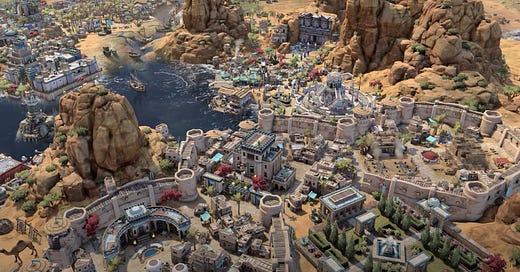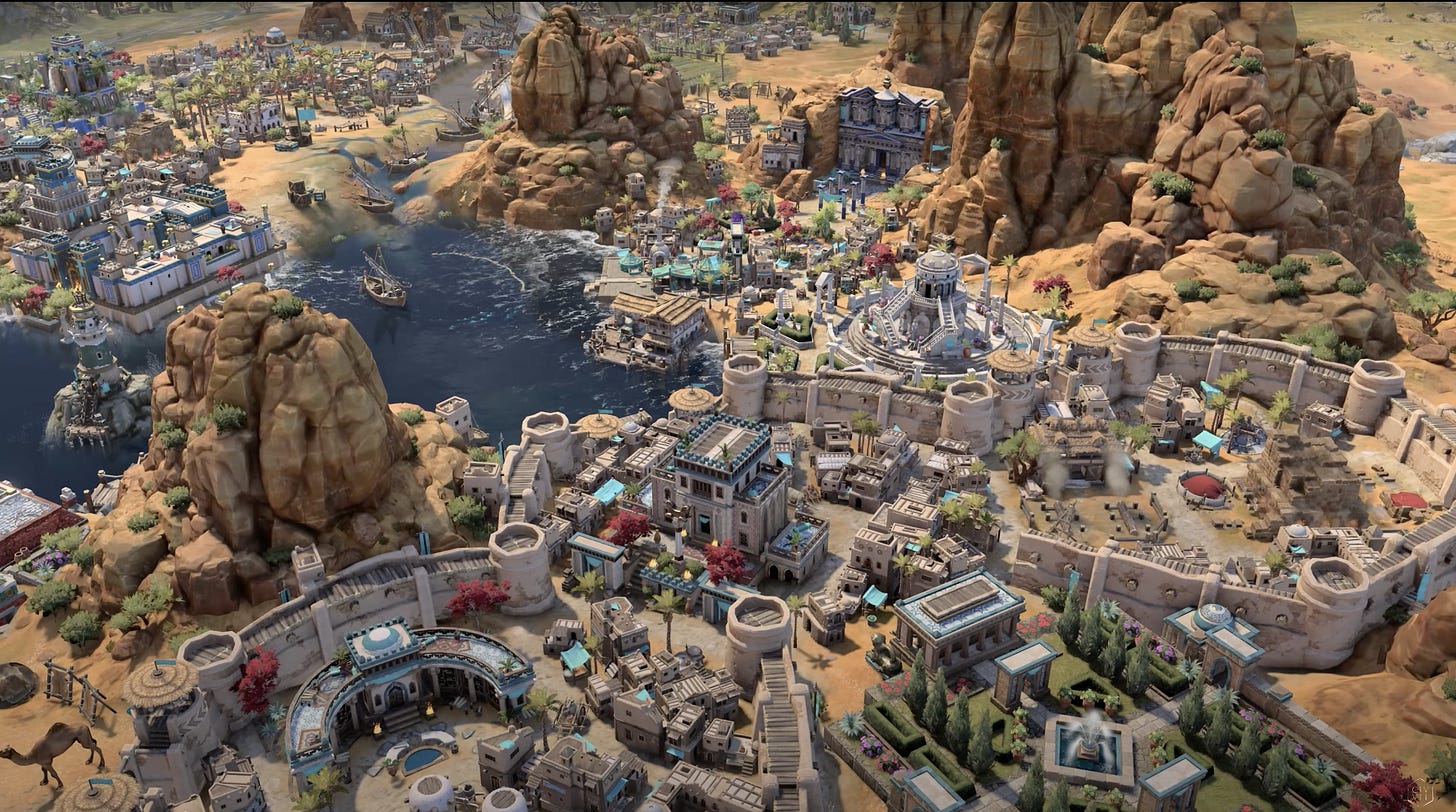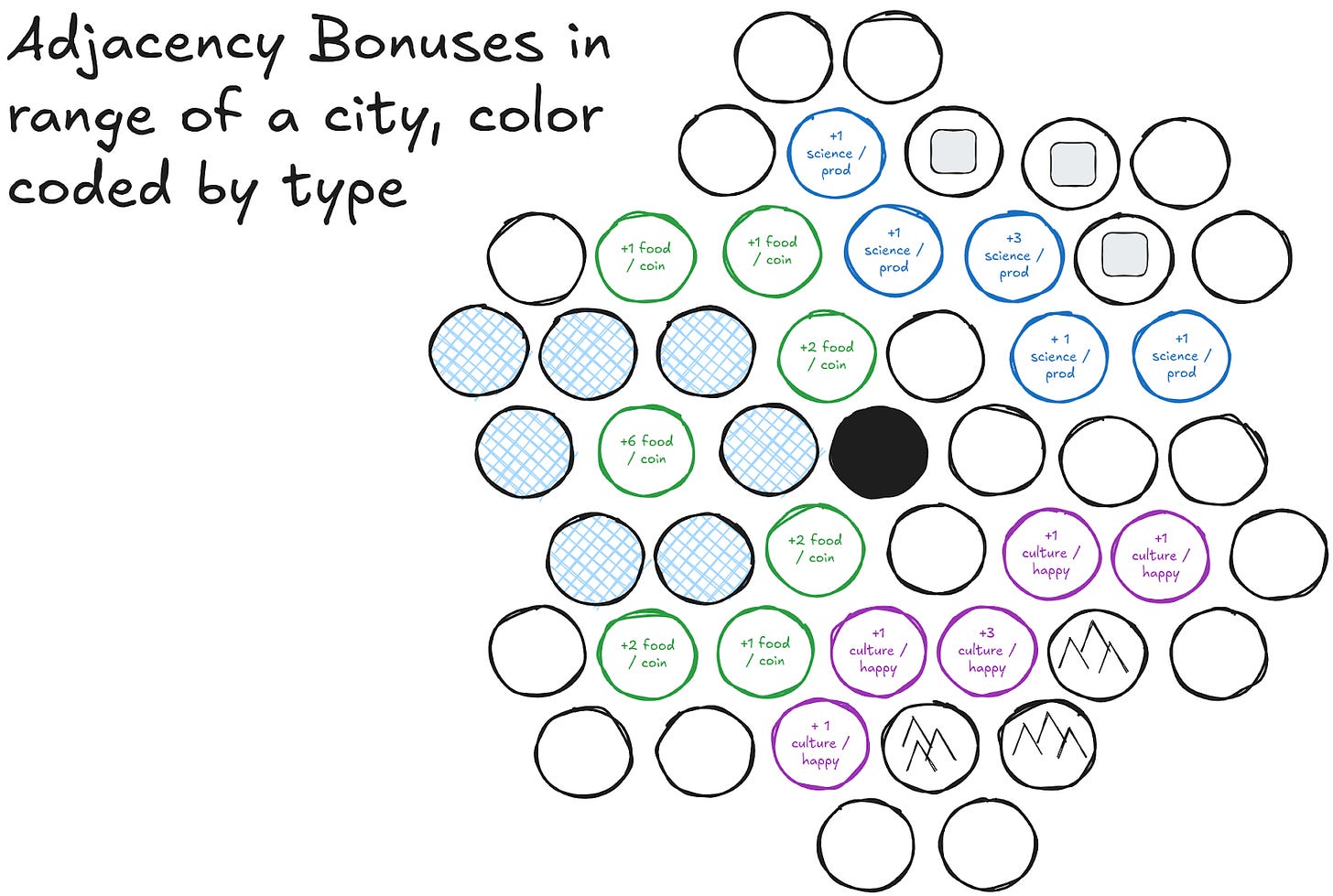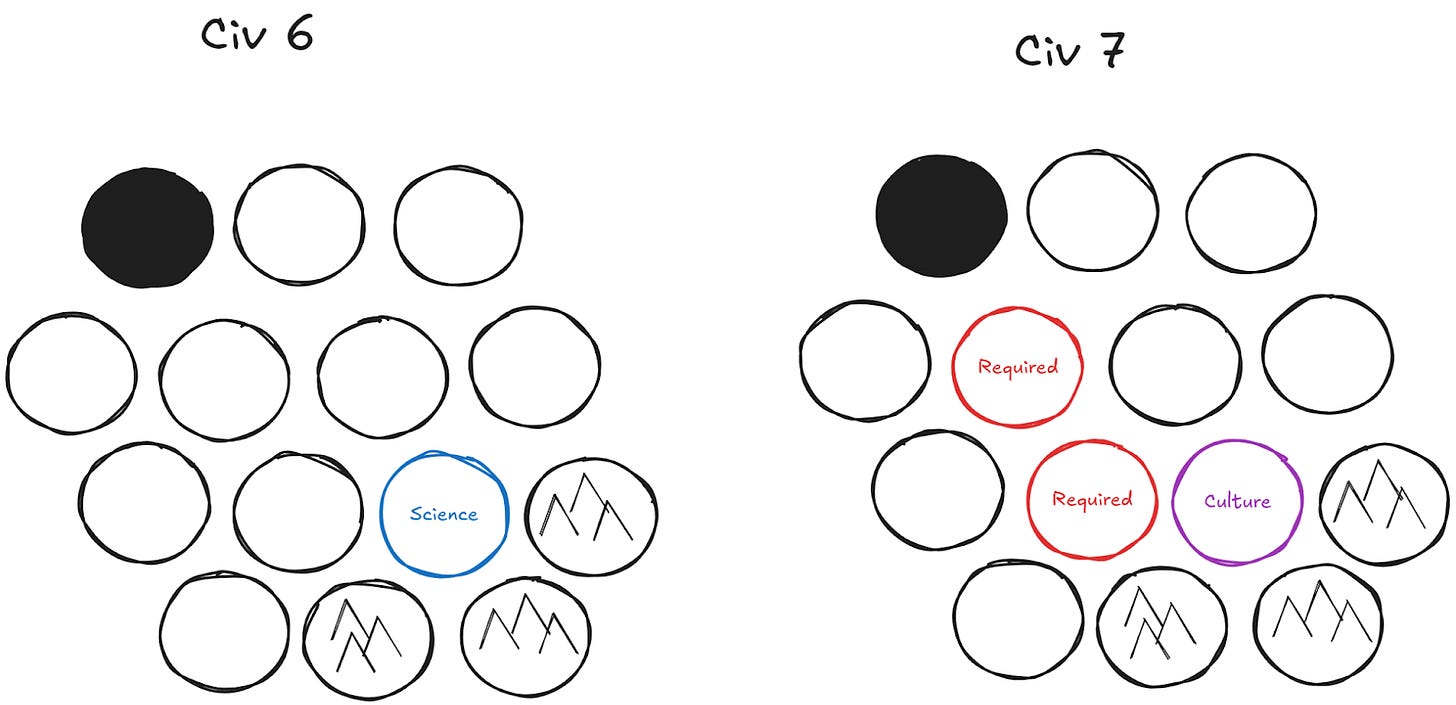Every time I've written about Civ 7, I've written about waging war. Partly that's because the war-gaming really shines, and it's easily the most fleshed out game system. But partly that's because I didn't really feel like I had a good enough grasp of the rest of the systems to comment on them, much less give anyone advice.
Well, I'm another 100 hours into this game, so I think I can opine on at least one other core mechanic: city planning.
Cities are vital for powering your path to victory. No matter how you choose to play the game, you are going to need food, production, coin, science, and culture to actually accomplish anything of value. That in turn means that you need to think through how to maximize each of those resource counts. In general, more settlements is good, and so you should more or less always try to max out your settlement cap. But a really well planned settlement, or a settlement that is extremely well placed, can be worth 2-3 "mid" alternatives. In Civ 6, knowing where and how to settle was a critical part of being competitive and winning in multiplayer or deity. Civ 7 is no different.
Where to Settle
Well, you have to pop down your settlement somewhere! Might as well make it good.
In Civ 6, "good" was pretty standard and did not change throughout the game. You needed to settle on water, because the housing penalties were crippling. Generally you were looking for at least 2 food yields on nearby tiles (since a single pop cost 2 food to maintain). Mountains were a plus but not necessary. Settling on a hill was also good but not necessary. And putting cities really close to each other so that they could share adjacencies was extremely useful, especially along rivers.
In Civ 7, the general definition of "good" changes by era and settlement type. Some places are fantastic settlement spots for Antiquity era cities, and totally useless as modern era towns.
Antiquity era settlements are going to be the core of any Civ 7 game, so we'll start there. Here's a general guide to how I think about placing early settlements:
You want strong cities with great adjacencies that have a lot of space to grow. That in turn means space. Antiquity is about carving out land, so scout early and send settlers as far as your military can comfortably defend.
Your biggest cities should be coastal or have naval access — as I've written in the past, navy is a critical part of the mid and late game, and you are going to want your production engines to be able to easily spit out ships.
In terms of yields, production and food are the most important, and happiness is least important. If you have a choice between two good spots, pick the one that has more of the former than the latter. By the same token, look for areas that have extra yields. Navigable rivers, flood plains, and volcanic soil are all great places to settle near. I try to settle in the tropics, because wet land produces clay pits which are the strongest kind of workable improvement.
Look for areas with vegetation for cities and flat land for towns, since it is easy to get yield boosts for sawmills and farms respectively.
If you see camels, settle near them. Camels massively increase your available trade resource slots, which a) gives you legacy points in Antiquity and b) increases the productivity of your empire if you can fill those extra slots up.
As in other civ games, certain wonders or abilities make specific settlement locations more viable. Petra will turn any desert into a metropolis and Mundo Perdido is fantastic for tropical power houses. Incan terrace farms can rack up insane bonuses, while Hawaiian traditions make every single ocean tile a source of culture and happiness. As you get better at the game, try to place settlements in locations that will benefit from civs you take in future eras.1
Adjacency Bonuses, Specialists, and Urban Expansion
As in Civ 6, every district in 7 has a geographic adjacency bonus. Culture and happiness buildings get bonuses from being next to mountains. Science and production buildings get bonuses from being next to resources. Food and coin buildings get bonuses from being next to the coast.
Every specialist added to a tile multiplies the adjacency bonus, increasing it by 50%. If you have a culture building next to 3 mountains, each additional specialist adds +1.5 culture. If you have two culture buildings in the same quarter, you get +3 culture per specialist. It's possible to rack up some extremely high adjacency bonuses. A market on a one tile island can generate a whopping +4 coin per specialist.
When you transition eras, most of your previous buildings2 lose their adjacency bonuses. That means those additional specialists are just costing you resources. It is critical to replace the buildings with the most specialists as soon as possible. If you're planning your cities and specialists correctly, the districts with the most specialists should basically always be the ones with the best positioning.
Note that the UX can be deceptive here! If you just blindly build buildings wherever the yield count is highest, you may not be maximizing your yields. Make sure you're overbuilding with the right adjacency bonuses in mind.
Because of the way adjacencies and specialists work, you generally want to maximize at least one kind of building adjacency. In other words, look for places where you can get +3/4/5 on your culture/happiness and science/production buildings, and then dump specialists there. I purposely left out coin/food — settling anywhere on the coast will generally get you a solid adjacency count, and coin/food have diminishing margins of return if you cannot turn them into science/culture.
That's not to say you should ignore coin or food. Cities need high pop to be useful. The higher pop, the more specialists, the more you can juice your science and culture districts. And coin is imo the most important resource — coin is like production in that you use it to directly feed back into your growth engine, but there is an added benefit in that coin is the only way to improve your towns.
So, overall, if you can get good yields AND be on the coast or on a navigable river, you're golden.3
Hopefully by now we already have some basic sense of how to plan our cities. The building types with the same yield adjacencies should end up in the same quarters, and the main city should probably be coastal somewhere. Can we do better?
Good players will know how to utilize the geography. The best players will figure out how to plan their cities such that the randomness of geography matters much less.
In Civ 6, that was through district-district adjacency bonuses. For example, industrial zones would get bonuses from aqueducts, so you would want to leave room for an aqueduct and an IZ to be next to each other. This in turn helped build good cities even in places where the geography was not that great.
In Civ 7, you focus on wonders and unique quarter buildings.
Every district gets a flat +1 bonus from being next to a wonder. Like every other adjacency bonus, that +1 scales per specialist. You want to plan your wonder building so that the wonders are as surrounded as possible, while also structuring your wonders around the buildings that already have the most adjacencies available.
Unique district buildings are the only kind of district that can have a district-district adjacency. Specifically, many unique buildings (like the Roman Basilica, the Mayan Jalaw, or the Greek Odeon) get an extra adjacency for being next to another quarter or district. These buildings are also unique in that they are ageless and so never lose their adjacency bonuses, which make them vital for getting up and running after an era transition. As you might expect, having these quarters in the center of your city is a great way to maximize returns.
It sounds like it's pretty easy to get good adjacency bonuses if you settle in the right spot. Unfortunately, there is one other wrinkle.
In Civ 6, you could plop your districts wherever you wanted, and you could buy up tiles. That meant that within a turn of settling, you could theoretically start working on building a campus near a cluster of mountains 3 tiles away.
That's not true in Civ 7. In your cities, every one of your urban tiles needs to connect to at least one other urban tile. So if you're settling on water, and you have a cluster of mountains three tiles away, you need to build at least two other buildings before you can start working on the district that actually has good bonuses.
In other words, the game forces trade-offs. Do you go for a production building that's nearby for the immediate boost, or do you wait to build it until you can get over to a farther, better location? Do you go for the fantastic mountain range or the coast? Do you buy so you can get to important buildings faster, or use production and save your coin for cities and units? Eventually your cities may become big enough to cover all the high adjacency areas you see. But in the short term you need to optimize. That means that when you settle a city, you should have a plan for how you're going to snake your urban buildings up wherever they need to go.
Generally, buying cheaper buildings helps a lot here. Many people have maligned the antiquity era warehouse buildings (sawmill, granary, and brickyard) for being ageless and not having particularly good yields. But their price does not change, and an urban building is an urban building. In the mid and late game, you can quickly drop an antiquity warehouse building to get your other more important districts into position ASAP. Here too there is strategic choice: do you lose a tile permanently to a warehouse building, or do you wait and potentially lose an edge?
Towns
A lot of what I said above applies to towns as well as cities. If you're adding a building to a town, for eg, consider placing it in a location that will help you eventually reach a good adjacency cluster. Or alternatively, try to avoid placing buildings in areas that will block off other future buildings, should you want to convert to a city later on.
That said, when I settle, I generally have a good sense of whether that settlement will eventually become a city or stay a town forever. The reason is because towns basically exist for only two reasons: first, to get access to some niche resources like distant land resources or camels; and second, to provide food for cities. As a result, unlike my city placement which is focused on adjacencies, my town placement is basically always focused on food generation. Sure, there are edge cases where you want to have a town specialize into doing something else, but I'd say 90% of the time you should be placing and growing your towns to maximize food yields. That means farms and fishing boats.
The main reason to prioritize food in your towns is because that's the only way the towns grow. Unlike your cities, towns are generally not able to build districts that have adjacency bonuses. They mostly build warehouse buildings, and a few buildings important for legacy paths like factories and temples. As a result, you want to get a lot of rural tiles. The bigger the town, the more food, the more it will grow, and the more you will eventually be able to send to nearby cities. And you really do want to have big towns, because the happiness penalties from going far over your settlement cap can be crippling — remember, it's -2% yields for every happiness point below 0.4
I'm never quite sure when to turn towns into cities. One simple answer is "as soon as you can". This makes some amount of sense, after all you do have a settlement cap and you really want to get as much out of each settlement as possible. Cities are inherently more valuable than towns simply because you can buy way more buildings instead of waiting for food growth, and each building is an extra pop.5
Still, I find that I rarely transition all of my towns. I'll generally have two cities by antiquity; 4 or 5 by exploration; and maybe 7 by modern. I think I'll build a better intuition for when exactly to make this transition after playing another 100 hours.
Which I'll go do right now.
You might also like
Civ 7: War Strategy and Tactics
[Note: I haven’t written about Civ since March, and since then my subscriber count has increased by 400%. So…uh…just a heads up that all of you newer subscribers will also be getting very niche Civ 7 content in your inbox. Enjoy!]
The civ unlock system helps with this a bit. Generally, you'll only unlock civs that will somehow benefit your current build.
Some legacy bonuses let you keep some adjacency bonuses, and we'll talk more about unique buildings in a second.
Note again the incentives to settle on waterways! The game really makes navy extremely important.
There are cases where you can do pretty whacky things with hub towns, and sometimes you will want a fort town if you forward settle someone. That's the other 10%. The default is food.
This is also a way to quickly get to the 5 pop limit for building settlers in antiquity!











